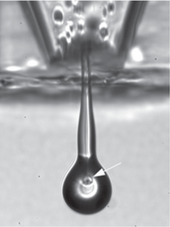Keith Martin BM BCh DM MRCP FRCOphth ALCM is an ophthalmologist.
He is the inaugural Professor of Ophthalmology at the University of Cambridge and a specialist in the treatment of glaucoma. In 2013, Professor Martin's team tested a novel technique of bio-printing, using an ink jet to recreate layers of ganglion and glial cells from a rat's retina, a process that has been described as 'printing eyeballs'.

Early life and education
editMartin was educated at The Royal School, Armagh, from 1980 to 1987, and was head boy in his final year.[1] He then won a place at St Catharine's College, Cambridge to read medical science and neuroscience. He graduated with first class honours in three subjects.[1]
He qualified as a medical doctor at Oxford University in 1993. He then did medical research at several institutions in the USA and UK including: the UCL Institute of Ophthalmology, Moorfields Eye Hospital and the Wilmer Eye Institute.[1][2]
Career
editHe has specialised in the treatment of glaucoma and in 2005 he established the Glaucoma Research Laboratory at Cambridge.[1] He is also an editor of the Journal of Glaucoma and treasurer of the World Glaucoma Association.[1]
In 2009 he became Cambridge University's Professor of Ophthalmology. This was a new chair, sponsored by the Cambridge Eye Trust.[3] In 2013, he worked with Dr Barbara Lorber and others on the use of a piezoelectric inkjet nozzle to spray ganglion and glial cells from a rat retina.[4] The cells survived the process of deposition in layers and continued to grow in culture. With further development and testing, techniques like this could have clinical application for the repair of damaged retinas.[5][6]
In 2018, Keith became president of the World Glaucoma Association (WGA), the world's largest glaucoma association.
In 2019, Martin moved to Melbourne where he became the Managing Director for the Centre for Eye Research Australia (CERA) and the head of Ophthalmology at the University of Melbourne.
Family life
editKeith Martin is married and has three children. He lives in Melbourne.[1] His wife, Susie, is better known as Dr. Susan Harden, the thoracic oncologist and Lead Clinician in Lung Cancer at Addenbrooke Hospital before moving to Australia in late 2019 .[1]
Honours and awards
edit2010: ARVO Pfizer Ophthalmics Carl Camras Translational Research (TR) Award, or 'ARVO Camras Award for TR'. This is an award for young researchers with innovative work that shows potential for clinical application.[7]
Publications
edit- Keith Martin (2009), Mechanisms of Retinal Ganglion Cell Death in Glaucoma: New Approaches to the Pathogenesis and Treatment of the Silent Thief of Sight, VDM Publishing, ISBN 9783639161656
See also
editReferences
edit- ^ a b c d e f g Keith Martin, MA BM BCh DM MRCP FRCOphth ALCM 1980–1987, Head Boy (1986–1987), Royal School, Armagh, retrieved 7 June 2014
- ^ Keith Martin, MA, DM, MRCP, FRCOphth, University of Pittsburgh, 2014
- ^ What We Do, Cambridge Eye Trust, 2012
- ^ Barbara Lorber; Wen-Kai Hsiao; Ian M Hutchings; Keith R Martin (17 December 2013), "Adult rat retinal ganglion cells and glia can be printed by piezoelectric inkjet printing", Biofabrication, 6 (1): 015001, doi:10.1088/1758-5082/6/1/015001, PMID 24345926
- ^ Michelle Roberts (18 December 2013), Scientists 'print' new eye cells, BBC, retrieved 16 June 2014
- ^ "The Man Who Prints Eyeballs", ShortList, 29 May 2014
- ^ Pfizer Ophthalmics Carl Camras Translational Research Awards, ARVO Foundation for Eye Research, 2010, archived from the original on 14 August 2015, retrieved 7 June 2014
External links
edit- profile at the Department of Clinical Neurosciences